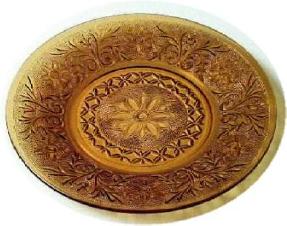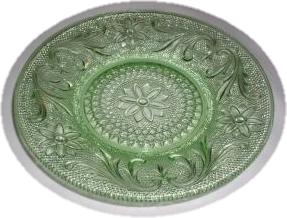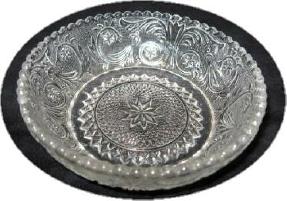National Depression Glass Association
Preserving America's Glass Manufacturing Heritage
Sandwich Glass Patterns
by Kathy Eickholt
Several glass companies made Sandwich glass and it can be challenging to tell their patterns apart.
Lacy swirls of scrolls and flowers were pattern motifs from the
Boston & Sandwich Glass Company in the 1800s. While little
glass from this era survives today, the spirit lives on in glass
made from the 1930s through 1980s by companies such as Duncan &
Miller,  Anchor Hocking and Indiana Glass. These
companies acknowledged the Boston & Sandwich Company by calling
patterns with similar motifs Sandwich glass.
Anchor Hocking and Indiana Glass. These
companies acknowledged the Boston & Sandwich Company by calling
patterns with similar motifs Sandwich glass.
With the number of patterns, all called Sandwich, how can the collector tell them apart? Here are a few easy tips.
The flowers in Anchor Hocking's Sandwich pattern (at left)are
the only ones with double lines around the flower petals. In fact,
a customer told me this was called "Double Sandwich." It's an easy
way to remember! The scrolls are more scrunched together than other
patterns, but unless you  have others to compare, just remember the
double lines. Hocking made Sandwich in crystal, Ruby Red and Forest
Green, and you can find some pieces in amber, white and pink.
have others to compare, just remember the
double lines. Hocking made Sandwich in crystal, Ruby Red and Forest
Green, and you can find some pieces in amber, white and pink.
Indiana's Sandwich (at right)comes in many colors because
Indiana sold it in a rainbow of colors through their Tiara party
plan in the 1970s and 1980s. Tiara's Sandwich was mostly the same
pattern that Indiana sold originally in the late 1920s and 1930s.
Indiana's Sandwich is pretty, with graceful long scrolls between
simple flowers. The scrolls do not  touch in the middle. It's
probably easiest to tell Indiana by deciding it is not Anchor
Hocking or Duncan & Miller.
touch in the middle. It's
probably easiest to tell Indiana by deciding it is not Anchor
Hocking or Duncan & Miller.
Duncan & Miller's Early American Sandwich glass (at left) is the best made and highest quality glass of these three. It was a long-running staple of Duncan & Miller until 1955 and was made in a full table service plus fascinating incidental pieces such as baskets and epergnes. To identify Duncan's glass, look where the scrolls come together. If there is a horizontal diamond connecting the scrolls, it is Duncan's Sandwich. A similar pattern is Princess Feather from Westmoreland, which has an oval connector instead of a diamond.
Webmaster's NOTE: The NDGA wishes to thank the author for permission to use this article. Kathy is a dealer from Midland, Michigan. Her web site is Cat Lady's Glass.